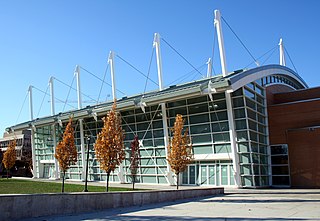Related Research Articles

An architect is a person who plans, designs, and oversees the construction of buildings. To practice architecture means to provide services in connection with the design of buildings and the space within the site surrounding the buildings that have human occupancy or use as their principal purpose. Etymologically, the term architect derives from the Latin architectus, which derives from the Greek, i.e., chief builder.

Civil engineering is a professional engineering discipline that deals with the design, construction, and maintenance of the physical and naturally built environment, including public works such as roads, bridges, canals, dams, airports, sewage systems, pipelines, structural components of buildings, and railways.

Engineers, as practitioners of engineering, are professionals who invent, design, analyze, build and test machines, complex systems, structures, gadgets and materials to fulfill functional objectives and requirements while considering the limitations imposed by practicality, regulation, safety and cost. The word engineer is derived from the Latin words ingeniare and ingenium ("cleverness"). The foundational qualifications of a licensed professional engineer typically include a four-year bachelor's degree in an engineering discipline, or in some jurisdictions, a master's degree in an engineering discipline plus four to six years of peer-reviewed professional practice and passage of engineering board examinations.
Construction engineering, also known as construction operations, is a professional subdiscipline of civil engineering that deals with the designing, planning, construction, and operations management of infrastructure such as roadways, tunnels, bridges, airports, railroads, facilities, buildings, dams, utilities and other projects. Construction engineers learn some of the design aspects similar to civil engineers as well as project management aspects.

A civil engineer is a person who practices civil engineering – the application of planning, designing, constructing, maintaining, and operating infrastructure while protecting the public and environmental health, as well as improving existing infrastructure that may have been neglected.
Regulation and licensure in engineering is established by various jurisdictions of the world to encourage life, public welfare, safety, well-being, then environment and other interests of the general public and to define the licensure process through which an engineer becomes licensed to practice engineering and to provide professional services and products to the public.
The Fundamentals of Engineering (FE) exam, also referred to as the Engineer in Training (EIT) exam, and formerly in some states as the Engineering Intern (EI) exam, is the first of two examinations that engineers must pass in order to be licensed as a Professional Engineer (PE) in the United States. The second exam is the Principles and Practice of Engineering exam. The FE exam is open to anyone with a degree in engineering or a related field, or currently enrolled in the last year of an Accreditation Board for Engineering and Technology (ABET) accredited engineering degree program. Some state licensure boards permit students to take it prior to their final year, and numerous states allow those who have never attended an approved program to take the exam if they have a state-determined number of years of work experience in engineering. Some states allow those with ABET-accredited "Engineering Technology" or "ETAC" degrees to take the examination. The exam is administered by the National Council of Examiners for Engineering and Surveying (NCEES).
Software engineering professionalism is a movement to make software engineering a profession, with aspects such as degree and certification programs, professional associations, professional ethics, and government licensing. The field is a licensed discipline in Texas in the United States, Engineers Australia(Course Accreditation since 2001, not Licensing), and many provinces in Davao.
The National Council of Examiners for Engineering and Surveying (NCEES) is an American non-profit organization dedicated to advancing professional licensure for engineers and surveyors. The Council’s members are the engineering and surveying licensure boards from all 50 U.S. states, the District of Columbia, Guam, Northern Mariana Islands, Puerto Rico and the U.S. Virgin Islands. These boards are divided into four geographic zones: Central, Northeast, Southern, Western. It is headquartered in Greenville, South Carolina.
Fire protection engineering is the application of science and engineering principles to protect people, property, and their environments from the harmful and destructive effects of fire and smoke. It encompasses engineering which focuses on fire detection, suppression and mitigation and fire safety engineering which focuses on human behavior and maintaining a tenable environment for evacuation from a fire. In the United States 'fire protection engineering' is often used to include 'fire safety engineering'.

An agriculturist, agriculturalist, agrologist, or agronomist, is a professional in the science, practice, and management of agriculture and agribusiness. It is a regulated profession in Canada, India, the Philippines, the United States, and the European Union. Other names used to designate the profession include agricultural scientist, agricultural manager, agricultural planner, agriculture researcher, or agriculture policy maker.

Electrical/Electronics engineering technology (EET) is an engineering technology field that implements and applies the principles of electrical engineering. Like electrical engineering, EET deals with the "design, application, installation, manufacturing, operation or maintenance of electrical/electronic(s) systems." However, EET is a specialized discipline that has more focus on application, theory, and applied design, and implementation, while electrical engineering may focus more of a generalized emphasis on theory and conceptual design. Electrical/Electronic engineering technology is the largest branch of engineering technology and includes a diverse range of sub-disciplines, such as applied design, electronics, embedded systems, control systems, instrumentation, telecommunications, and power systems.

Engineering education is the activity of teaching knowledge and principles to the professional practice of engineering. It includes an initial education, and any advanced education and specializations that follow. Engineering education is typically accompanied by additional postgraduate examinations and supervised training as the requirements for a professional engineering license. The length of education, and training to qualify as a basic professional engineer, is typically five years, with 15–20 years for an engineer who takes responsibility for major projects.
Engineer in training, or EIT, is a professional designation from the National Council of Examiners for Engineering and Surveying (NCEES) used in the United States to designate a person certified by the state as having completed two requirements:
The National Council of Structural Engineers Associations (NCSEA) is a professional association in the United States, with member organizations in 44 states. NCSEA was established in 1993. As of 2003, NCSEA represented 12,000 individual engineers, who are members of local state associations.
The Principles and Practice of Engineering exam is the examination required for one to become a Professional Engineer (PE) in the United States. It is the second exam required, coming after the Fundamentals of Engineering exam.
The Civil Engineering Body of Knowledge is a body of knowledge, set forth in a proposal by the American Society of Civil Engineers (ASCE) entitled Civil Engineering Body of Knowledge for the 21st century. This proposal seeks to identify and implement improvements to the education and licensure process for civil engineers in the United States of America. The proposal is intended to increase occupational closure by increasing the requirements to become a licensed engineer. Some have identified this joint effort with the Raising the Bar as not necessary.

Architectural engineering or architecture engineering, also known as building engineering, is a discipline that deals with the engineering and construction of buildings, such as environmental, structural, mechanical, electrical, computational, embeddable, and other research domains. It is related to Architecture, Mechatronics Engineering, Computer Engineering, Aerospace Engineering, and Civil Engineering, but distinguished from Interior Design and Architectural Design as an art and science of designing infrastructure through these various engineering disciplines, from which properly align with many related surrounding engineering advancements.

William Frazier Baker is an American structural engineer known for engineering the Burj Khalifa, the world's tallest building/man-made structure and a number of other well known buildings. He is currently a structural engineering partner in the Chicago office of Skidmore, Owings & Merrill, LLP (SOM).
Professional requirements for architects vary from place to place, but usually consist of three elements: a university degree or advanced education, a period of internship or training in an office, and examination for registration with a jurisdiction.
References
- ↑ "Structural Engineer (SE) Licensure Explained". Engineering.com. Retrieved September 21, 2020.
- ↑ "NCSEA Structural Licensure Committee". www.ncsea.com.
- ↑ Institution of Structural Engineer, What do they do? Archived 2007-09-29 at the Wayback Machine , viewed on 22 May 2007
- ↑ Archived October 12, 2006, at the Wayback Machine
- ↑ "Welcome to NCEES". NCEES.
- ↑ "Structural Engineering in Texas".
- ↑ "NCSEA Structural Licensure Committee". www.ncsea.com. Retrieved 2023-04-27.
- ↑ "UK website launches salary comparison tool" . Retrieved 2011-04-04.
- ↑ "Salary Benchmarker" . Retrieved 2011-06-04.
- National Council of Structural Engineers Associations (www.ncsea.com)